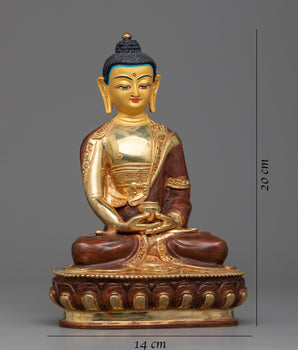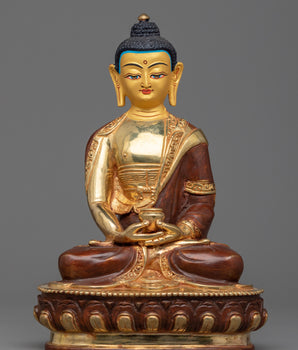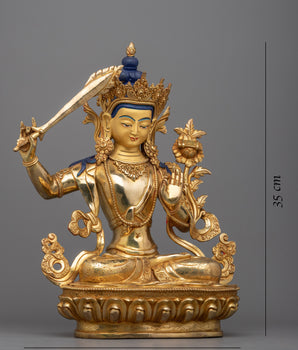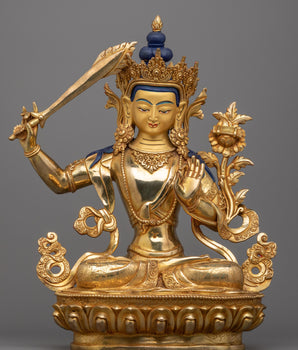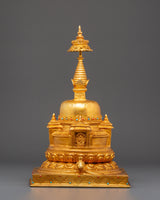
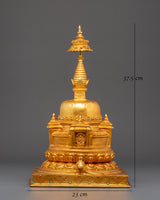
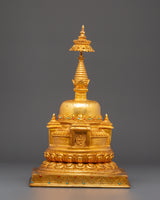
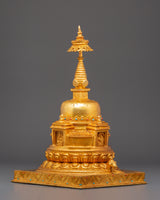
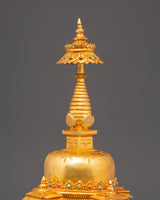
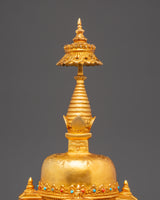
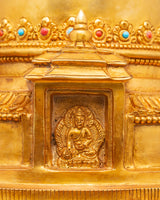
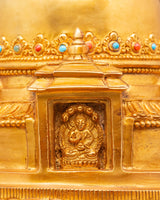
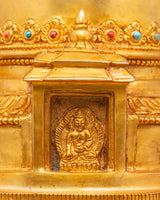

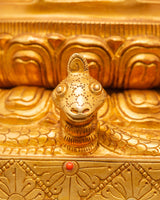
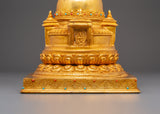
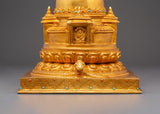
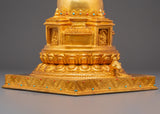
Golden Stupa for Ritual Ceremonies | Symbol of Enlightenment

100% AUTHENTIC

HANDMADE

FREE SHIPPING
Perfect for Meditation and Spiritual Ceremonies | Tibetan Golden Stupa for Ritual Ceremonies
--------------------------------------------------
Size: 37.5cm (Height) x 23cm (Width)
Weight: 5.27kg
Materials: Copper Body, Gold Plated
--------------------------------------------------
About Our Ritual Item :
This Golden Stupa for Ritual Ceremonies is a gorgeous portrayal of the Buddhist path to enlightenment, richly adorned with spiritual meaning. Standing 37.5cm tall and 23cm wide, this gold-plated copper stupa is intended for use in Tibetan Buddhist rituals, providing a concrete connection to the Buddha's hallowed teachings. The stupa is a physical embodiment of the Buddha's teachings, utilized in rituals to represent enlightenment, offering, and protection.
The stupa's gold-plated copper body is magnificently crafted, with delicate carvings emphasizing the design's spiritual symbolism. The stupa's shape depicts the Buddha's body, speech, and mind, while the jewel-like ornaments around the base and spire indicate the knowledge, compassion, and power of the enlightened mind. The ornamental designs and gemstone embellishments give beauty and vibrancy, emphasizing its importance as a ritual item with spiritual meaning during offerings and meditation activities.
This Tibetan Buddhist golden stupa is ideal for use in puja ceremonies, meditation areas, or as part of a larger altar set-up. Whether utilized in ritual offerings or as an artistic spiritual work, it will provide heavenly protection, peace, and a connection to enlightened understanding. The stupa not only beautifies your environment, but it also acts as a continual reminder of Buddhism's core precepts of impermanence, compassion, and enlightenment.
Introduction To Stupa :
Before Buddhism, great teachers were buried in mounds. Some were cremated, but sometimes they were buried in a seated, meditative position. The mound of earth covered them up. Thus, the domed shape of the stupa came to represent a person seated in meditation, much as the Buddha was when he achieved Enlightenment and knowledge of the Four Noble Truths. The base of the stupa represents his crossed legs as he sat in a meditative pose. The middle portion is the Buddha’s body, and the top of the mound, where a pole rises from the apex surrounded by a small fence, represents his head. Before images of the human Buddha were created, reliefs often depicted practitioners demonstrating devotion to a stupa.
How to Set Up Your Own Buddhist Shrine?
• Find a clean, quiet, and uncluttered spot
• Set up an altar table, and cover it with an altar cloth that calls to you
• Place your sacred item at the center
• If you want a more elaborate altar, you can put a Stupa as well.



















